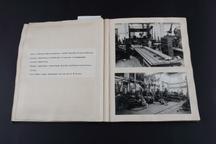

Ransomes and Rapier Limited
In the summer of 1869, James Allen Ransome, Robert James Ransome, Richard Christopher Rapier and A.A. Bennett, left the Ipswich company, Ransomes, Sims & Head, now Ransomes, Sims & Jeffries Ltd., by agreement to establish a new company, Ransomes & Rapier, on a site on the west bank of the River Orwell, which they appropriately named Waterside Works. They continued their already established business, the manufacture of points and. crossings, rail wedges and trenails for railways. By 1874, a steam locomotive had been built for use in construction work on the Shanghai and Woosung Railway and it was the first locomotive to run in China.
Many of the cranes and equipment developed for railways had other industrial applications, and the Company was involved in a wide variety of general engineering projects, including the building of steam and electric dockside, overhead and Goliath cranes and in 1904, the revolving stage at the London Coliseum Theatre. They then moved into manufacturing and holding the patents for water control gates. In 1902, sluice gates were made for the first Aswan Dam on the River Nile in Egypt with many other important installations in over 50 countries across the globe.
In 1932, the Company was the first in the United Kingdom to manufacture concrete mixers mounted on lorries, now universally known as Truck Mixers. In the Palace of Engineering at the British Empire Exhibition, at Wembley in 1923, Ransomes & Rapier exhibited the first petrol electric, rubber tyred mobile crane. Within a few years, Rapier Mobile Cranes were being used by railways, docks and industry and three sizes were in regular batch production for loads up to 7 tons. The designers then turned their attention to producing an even more manoeuvrable crane with a revolving superstructure and many variations in performance and load capacity of these types were produced.
In 1939 R&R quickly switched to a wide range of war work, including shells, guns, tank turrets and a lot more. There was also a good deal of work connected with ships. The works escaped damage in the first conflict but was heavily bombed in the second. Important shops and machinery escaped but there was serious loss of life following a shower of anti-personnel bombs and in one night the company lost a manager and several men. In the first world war Wilfred Stokes won a knighthood for inventing the trench mortar. The Royal Navy calling them in to design a catapult capable of launching an aircraft from a ship. In operation it was one of the most spectacular pieces of apparatus ever constructed at Waterside Works. It was telescopic and could be driven either by compressed air or an explosive charge.
The company closed in 1987 and in 1988 Bucyrus-Erie acquired the dragline assets of Ransomes and Rapier Ltd.